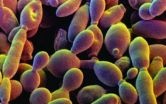Notre Dame researchers demonstrate antibiotic sensing event central to MRSA antibiotic resistance
2011-09-16
(Press-News.org) A new paper by a team of University of Notre Dame researchers that included Shahriar Mobashery, Jeffrey Peng, Brian Baker and their researchers Oleg Borbulevych, Malika Kumararasiri, Brian Wilson, Leticia Llarrull, Mijoon Lee, Dusan Hesek and Qicun Shi describes a unique process that is central to induction of antibiotic resistance in the problematic bacterium methicillin-resistant Staphylococcus aureus (MRRA).
MRSA first emerged in the United Kingdom in 1961and spread rapidly across the globe. Modern strains of MRSA are broadly resistant to antibiotics of various classes, but resistance to B-lactam antibiotics, which include penicillins, cephalosporins, and carpapenems, is an acute problem because it impacts virtually all commercially available members of the class.
Earlier research by Mobashery, who holds the Navari Family Chair of Life Sciences at Notre Dame, found that an antibiotic sensor/signal transducer protein called "BlaR1" is a key player in MRSA's resistance to β-lactam antibiotics. Specifically, he had detected by spectroscopy a unique recognition process by the BlaR1 protein of the antibiotic that the organism might encounter. This recognition event, termed "Lysine N-Decarboxylation Switch," involved formation of an N-carboxylated lysine within the antibiotic-binding domain of BlaR1, which experiences decarboxylation on binding to the antibiotic. This decarboxylation gives the antibiotic complex longevity, which benefits MRSA in the face of the antibiotic challenge. Although this antibiotic-recognition event was described by Mobashery's research group a few years earlier, the process was not visualized in atomic resolution, despite attempts by several other research groups.
The three collaborating groups of Notre Dame researchers approached the problem differently. The Peng group studies the process by three- and two-dimensional NMR spectroscopy in Notre Dame's Lizzardo Magnetic Resonance Research Center, the Baker group grew new crystals of the protein for x-ray diffraction and the Mobashery group applied computational methods to understand the process.
The efforts paid off, as Peng demonstrated the presence of N-carboxylated lysine in the protein and showed that it undergoes N-decarboxylation on binding to the antibiotic in solution. Baker visualized both the N-carboxylated lysine in the x-ray crystal structure of the uncomplexed form and showed that when the antibiotic complexed with the protein, the N-decarboxylation switch resulted in a stable complex critical to the manifestation of resistance.
The lysine N-decarboxylation switch triggers MRSA's antibiotic sensor domain to adopt the active state that leads to all the subsequent biochemical processes that enable resistance, an event that was investigated by computational analyses in the Mobashery lab in the present study.
The importance of this lysine N-decarboxylation switch for MRSA rests in the fact that the organism does not mobilize its resources until and unless it is exposed to the antibiotic. As such, in an economy of existence, the MRSA conserves its resources until BlaR1 informs it that it has come in contact with a B-lactam antibiotic.
The research paper describing the team's findings appears in the Journal of Biological Chemistry.
INFORMATION:
END
ELSE PRESS RELEASES FROM THIS DATE:
2011-09-16
Scientists have replaced all of the DNA in the arm of a yeast chromosome with computer-designed, synthetically produced DNA that is structurally distinct from its original DNA to produce a healthy yeast cell. (Yeast chromosomes are often depicted as bow tie-shaped--with each chromosome bearing two "arms" that are positioned similarly to the two sides of a bow tie.)
These results confirm that large pieces of DNA can be synthesized and inserted into a chromosome, and validate the research team's principles for designing synthetic chromosomes. Further, the researchers report ...
2011-09-16
Lyme disease is a dangerous disease which is transmitted by ticks. Blood-sucking ticks ingest the agents that cause the disease – bacteria of the species Borrelia burgdorferi and its relatives – during a blood meal, and subsequently transmit them to the next victim they feast on, often a person. It is estimated that, in Western Europe, up to half of all ticks carry the bacteria. Although the early symptoms of the illness are quite mild, if left untreated, it can result in serious damage to the skin, the joints, the heart and the nervous system, and effective therapy becomes ...
2011-09-16
SANTA CRUZ, CA--Using the Hubble Space Telescope to probe the distant universe, astronomers have found supermassive black holes growing in surprisingly small galaxies. The findings suggest that central black holes formed at an early stage in galaxy evolution.
"It's kind of a chicken or egg problem: Which came first, the supermassive black hole or the massive galaxy? This study shows that even low-mass galaxies have supermassive black holes," said Jonathan Trump, a postdoctoral researcher at the University of California, Santa Cruz. Trump is first author of the study, ...
2011-09-16
Secrets from the age of the dinosaurs are usually revealed by fossilized bones, but a University of Alberta research team has turned up a treasure trove of Cretaceous feathers trapped in tree resin. The resin turned to resilient amber, preserving some 80 million-year-old protofeathers, possibly from non-avian dinosaurs, as well as plumage that is very similar to modern birds, including those that can swim under water.
U of A paleontology graduate student Ryan McKellar discovered a wide range of feathers among the vast amber collections at the Royal Tyrrell Museum in southern ...
2011-09-16
GAINESVILLE, Fla. — Florida has the world's worst invasive amphibian and reptile problem, and a new 20-year study led by a University of Florida researcher verifies the pet trade as the No. 1 cause of the species' introductions.
From 1863 through 2010, 137 non-native amphibian and reptile species were introduced to Florida, with about 25 percent of those traced to one animal importer. The findings appear online today in Zootaxa.
"Most people in Florida don't realize when they see an animal if it's native or non-native and unfortunately, quite a few of them don't belong ...
2011-09-16
While whistleblowers are often respected for their willingness to stand up for what is right and report corporate or workplace corruption, they sometimes face tough consequences for their actions. However, federal legislation like the Dodd-Frank Wall Street Reform and Consumer Protection Act (Dodd-Frank) include provisions to protect whistleblowers from retaliation. Some whistleblower activities are also safeguarded through Securities and Exchange Commission (SEC) and Internal Revenue Service (IRS) federal agency practices.
Under the 2002 Sarbanes Oxley Act (SOX), covered ...
2011-09-16
Washington, DC (September 15, 2011) — Equations that estimate a patient's kidney function work as well as direct, invasive measurements, according to a study appearing in an upcoming issue of the Journal of the American Society Nephrology (JASN). This means that many patients with chronic kidney disease (CKD) do not need to undergo the painful and cumbersome procedures that are performed to monitor kidneys' health.
Measuring CKD patients' kidney function can help physicians anticipate complications and provide optimal treatments. Most measures focus on patients' glomerular ...
2011-09-16
Wouldn't it be nice if all those hours kids spent glued to their PlayStation 3, Xbox 360 or Nintendo DS video games actually resulted in something tangible? Better grades, perhaps? Improved concentration? Superior driving skills?
Over the past decade, many studies and news media reports have suggested that action video games such as Medal of Honor or Unreal Tournament improve a variety of perceptual and cognitive abilities. But in a paper published this week in the journal Frontiers in Psychology, Walter Boot, an assistant professor in Florida State University's Department ...
2011-09-16
A study published in the New England Journal of Medicine found that children covered by Medicaid or the Children's Health Insurance Program (CHIP) were less likely to be seen by specialists than their wealthier peers.
Researchers prepared two scripts for participants to use when they called 546 specialist clinics in Cook County, Illinois, home to Chicago and its surrounding suburbs. In one script, the callers, posing as mothers of sick children, reported symptoms of depression. In the other script, the callers described symptoms of type one diabetes.
Although neither ...
2011-09-16
People facing mounting debt have a few options for managing their debt, including debt consolidation and filing for Chapter 7 or Chapter 13 bankruptcy. Under Wisconsin law, debtors that reside in Wisconsin have an additional option: Chapter 128 debt amortization.
Chapter 128 is not bankruptcy; but it is similar to Chapter 13 bankruptcy in many ways. Chapter 128 allows debtors to consolidate their debts and pay them off over a three-year repayment period. Through Chapter 128, debtors are able to consolidate debts like medical bills, credit card bills, and missed rent ...
LAST 30 PRESS RELEASES:
[Press-News.org] Notre Dame researchers demonstrate antibiotic sensing event central to MRSA antibiotic resistance

